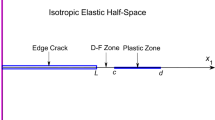Abstract
The method of continuously distributed dislocations and the method of discrete distribution of dislocations have been used to determine the effect of surface energy on the surface boundary conditions of a semi-infinite solid containing an edge dislocation. The surface dislocation model which incorporates two surface dislocation arrays, the primary and the secondary, in order of importance, is used to study the effect of surface energy. The surface dislocation model in conjunction with the method of continuously distributed dislocations enables the exact determination of the dislocation distribution function of the primary and secondary dislocation arrays and the effect of surface energy tends to lower both the total Burgers vector associated with the surface arrays and dislocations in evaluating the effect of surface energy is illustrated and is compared with the method of continuously distributed dislocations. It has been found that the surface energy tends to lower both the total Burgers vector associated with the surface arrays and the length of the region within which they are spread on the surface. Although the effect on the primary surface arrays is not very large, the secondary surface arrays are completely eliminated with normal values of surface energy encountered in real solids. Thus, the effect of surface energy is to bring non-vanishing stress components to the surface. The surface is also non-uniformly stressed. The superiority of the surface dislocation model over the other methods hitherto used in the literature is illustrated.
Similar content being viewed by others
References
F. R. N. Nabarro,Adv. Phys. 1 (1952) 269.
J. M. Burgers,Proc. Kon. Ned. Akad. Wetenschap. 42 (1939) 293.
J. P. Hirth andJ. Lothe, “Theory of Dislocations”, (McGraw Hill, New York, 1968).
T. Mura, in “Advances in Materials Research”, edited by H. Herman (Interscience, New York, 1968) pp. 3, 1.
A. K. Head,Proc. Phys. Soc. (London) B66 (1953) 793.
J. Weertman andJ. R. Weertman, “Elementary Dislocation Theory”, edited by M. E. Fine (Macmillan, New York, 1964).
K. Jagannadham andM. J. Marcinkowski,Phys. Stat. Sol. 50 (1978) 293.
Idem,Mater. Sci. Eng. (to be published).
Idem,J. Apply. Phys. (submitted).
J. D. Eshelby,Phil. Mag. 40 (1949) 903.
M. J. Marcinkowski, in “Advances in Materials Research”, edited by H. Herman, (Wiley, New York, 1971) pp. 5, 445.
M. J. Marcinkowski,Acta Mech. (to be published).
Idem, ibid (to be published).
N. I. Muskhelishvili, “Singular Integral Equations” (Noordhodd, Gröningen, Netherlands, 1953).
Author information
Authors and Affiliations
Rights and permissions
About this article
Cite this article
Jagannadham, K., Marcinkowski, M.J. Behaviour of an edge dislocation in a semi-infinite solid with surface energy effects. J Mater Sci 14, 1052–1070 (1979). https://doi.org/10.1007/BF00561288
Received:
Accepted:
Issue Date:
DOI: https://doi.org/10.1007/BF00561288




